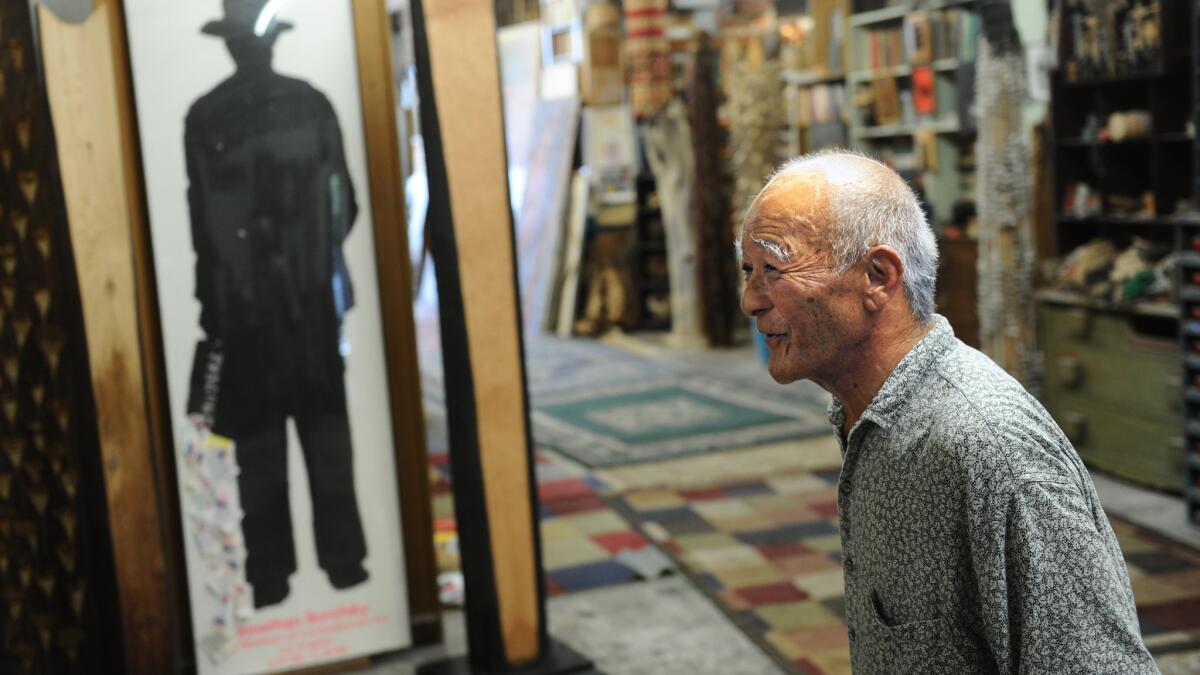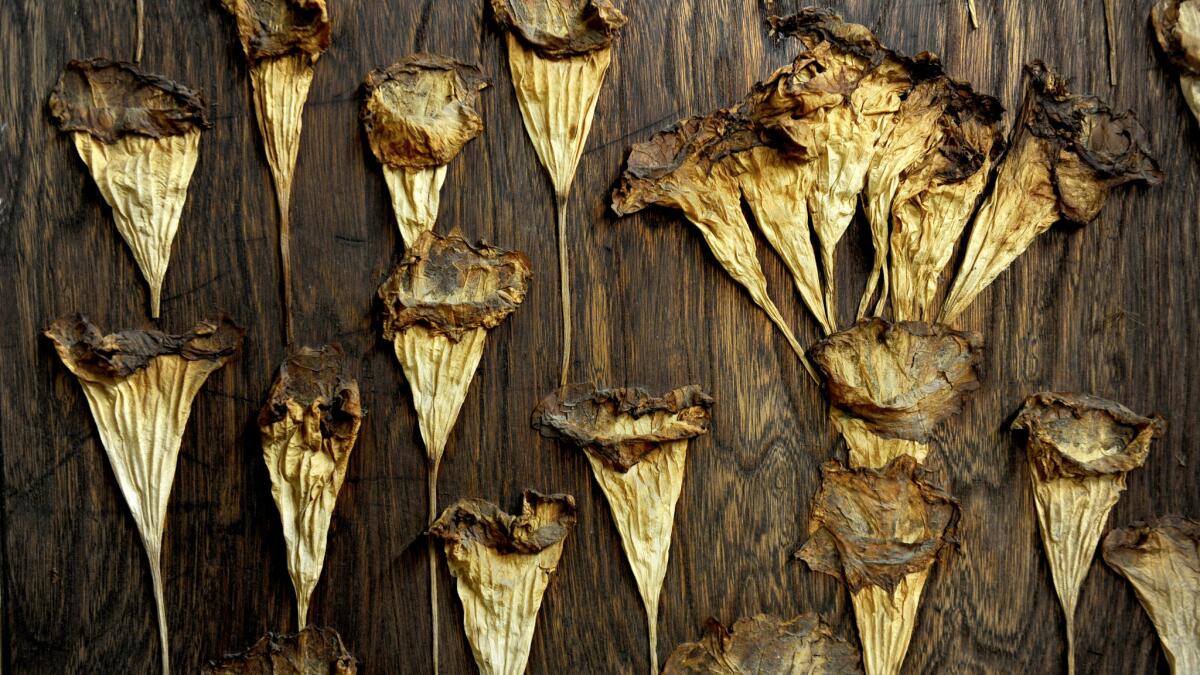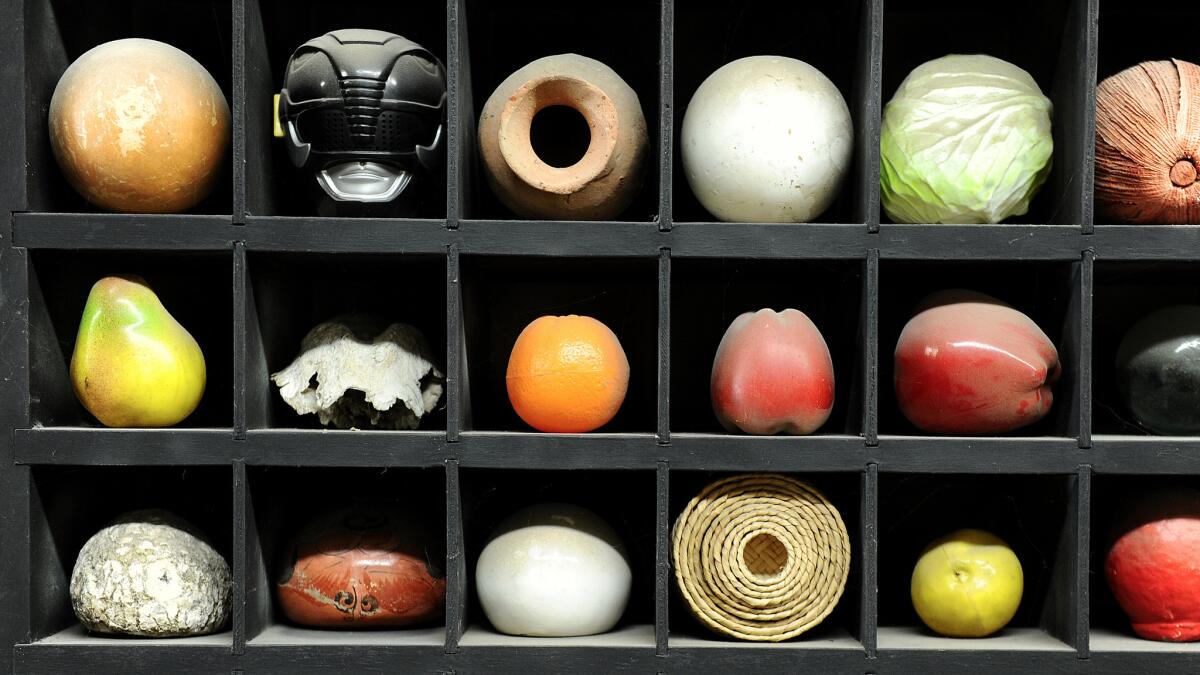The Hammer biennial’s breakout star? A 78-year-old retired gardener from Compton who once worked for Marlon Brando

- Share via
When artist Kenzi Shiokava received a telephone call from a pair of curators organizing this year’s “Made in L.A.” biennial at the Hammer Museum, he says he had little clue of the meteoric effect it would have on his life.
“I’d never seen ‘Made in L.A.,’” says the 78-year-old sculptor. “I’ve always been off the art establishment.”
But as he does with anyone who is interested in seeing his work, he invited the curators — Hamza Walker and Aram Moshayedi — to his studio so that they could have a look at his totemic wood sculptures, junk-art assemblages and curiosity boxes featuring orderly, patterned displays of old toys, plastic fruit and discarded religious ephemera.
Sign up for Carolina Miranda’s Essential Arts & Culture newsletter »
Shiokava says he was buoyed by the visit but subdued in his expectations. “Lots of shows come and go,” he says, as he surveys a row of partially carved tree limbs lining a wall of his studio.
But the biennial has been quite a different experience. “I didn’t know it’d be like this,” he says with a resplendent grin. “The response has been amazing.”
Shiokava, who has quietly whittled tree trunks and old telephone poles into mystical shapes in an old Compton body shop for several decades, made his living as a gardener for much of his life — including, at one point, for Marlon Brando. And yet he’s one of the breakout artists of the Hammer’s buzzy biennial, which opened to a warm critical embrace late last month.
Shiokava has been profiled on public radio and had a major Brazilian daily come calling for an interview (he was born in Brazil). W Magazine referred to him as one of the show’s stars. And a stream of collectors have been making the pilgrimage to a strip of light industrial spaces on West El Segundo Boulevard to see the tidy arrangements of collages, carvings and assemblages that make the artist’s workspace feel like an all-consuming environmental installation.
We were both speechless.... There were all of these totems ... and we were like, woooowwww.
— Hamza Walker, co-curator of “Made in L.A.” 2016
Walker, the biennial’s guest co-curator (he is an associate curator at the Renaissance Society in Chicago), says he stumbled into Shiokava’s work online while researching another artist. Calls to an art space in Reno, where the artist had exhibited in 2008, along with another to Cause Gallery, in L.A.’s Chinatown, which held a small number of his pieces, turned up his contact information.
The curator says that from the moment he and Moshayedi stepped into Shiokava’s studio, early in 2015, they were sure that this was an artist they wanted to include in the show.
“It was pretty immediate,” he says. “We were both speechless within 10 paces of the entrance. There were all of these totems right up front and we were like, woooowwww.”
For the exhibition, Walker says that he and Moshayedi, who is a curator for the Hammer, were looking to show a limited number of artists (roughly two dozen) — but to represent each of them with an extensive number of pieces.
“The idea was to feature a substantial project or body of work,” he explains. “When we saw Kenzi, we thought, ‘This confirms what we want to do.’” The biennial currently has 66 works by the sculptor on view.
Shiokava, who is exceedingly gracious and warm — he greets even first-time visitors to his studio with a hug — and possesses a bubbling energy that belies his age, couldn’t be more pleased.
“What’s always kept me going is people coming to my studio and enjoying the work,” he says in his deeply accented English. “But now I know my work will have a legacy. My work will live.”

Shiokava landed in Los Angeles, almost by chance, in the mid-1960s.
He was born and raised in Santa Cruz do Rio Pardo in Brazil, a small agricultural city roughly four hours west of São Paulo, where his parents, immigrants from southern Japan, operated a small grocery.
As a young man, Shiokava had considered studying something practical, like medicine. But he failed the entrance exam. “I was relieved,” he recalls. “I felt freer.”
In 1964, when he was 25, a friend in the Brazilian Air Force told Shiokava that he could secure free seats on a military flight to Los Angeles. The artist soon found himself California-bound, aboard a military transport unit.
After landing, he quickly settled on attending art school and becoming an artist. He was accepted at Chouinard (which later become CalArts) on the strength of a few paintings and sketchbooks he had produced over the years.
“It’s amazing!” he exclaims, of being accepted at Chouinard. “It’s like God was watching over me.”

Now I know my work will have a legacy. My work will live.
— Artist Kenzi Shiokava on his inclusion in the Hammer Museum’s “Made in L.A.”
But it wasn’t until his last year at Chouinard that he would find the medium for which he is now being celebrated. When he’d applied, Shiokava assumed that he’d become a painter — and devoted himself to studying drawing, painting and silkscreening, a medium in which he produced a rather predictable array of abstractions and landscapes.
But in his fourth year, he was required to complete a course in sculpture, a subject that filled him with dread. “Two weeks went by and I didn’t have a single idea of what to do — I was all empty there,” he says, gesturing towards his head.
It was a mindless bit of yardwork that led him to wood carving.

Shiokava had accumulated a number of pieces of discarded wood — among them an old railroad tie from the Angel’s Flight funicular in downtown Los Angeles — to put in the garden of what was then his Highland Park home.
“I started cleaning some of the wood and I realize: ‘That’s it! It’s wood!’” he says. “It has a history. It’s right there. I was so excited — nothing else mattered.”
He transformed that railroad tie, along with a number of other scraps, into a series of totemic, abstracted figures that he displayed at Chouinard’s gallery. Joan Ankrum, of Ankrum Gallery, saw the exhibition and gave him a solo show. A generally positive review in The Times, in the fall of 1972, noted his work’s “subtle and provocative undulations.”

But this early success didn’t quite translate into a gangbusters art career. Ankrum was unable to sell the work. And Shiokava carried on with this studies, going on to complete a master’s in fine arts at Otis Art Institute (now Otis College of Art and Design) in 1974.
Since then, Shiokava has produced a staggering body of work — principal among them, his totemic wood forms, inspired by both Japanese and Brazilian traditions, all imbued with a spectral feel. (Think: The kinds of unusual yet cordial sprites one could imagine emerging from an animated movie by Hayao Miyazaki.)
Much of the artist’s material is harvested from the streets and from construction sites, where he picks up dead trees and old lumber and hauls it back to his studio to transform it into something graceful and magical. Other pieces come from the peaceful garden he maintains at the rear of his studio, where he harvests moribund trees and the Seussian hulls of old cacti.
“I don’t want things to die, but sometimes they do,” he explains, “and I make work out of it.”
Shiokava has also long produced assemblage: thoughtfully arranged dioramas crafted from scavenged materials such as old action figures, industrial molds and the bits of bric-a-brac that turn up at thrift stores like St. Vincent de Paul and garage sales.
I didn’t even realize it was Brando’s house. I was just there to work on the pond.
— Kenzi Shiokava on his gardening work for Marlon Brando
This latter practice has connected him, socially and artistically, to a circle of African American artists working in Watts, including Noah Purifoy and John Outterbridge, figures who became known for making work out of the detritus of the Watts uprising. Shiokava, in fact, has been an artist in residence at the Watts Towers Art Center for many years — and his work was exhibited in a group show at the space during the Pacific Standard Time series of exhibitions in 2012.
Through the years, though, institutional support for his career has been tepid. He has had exhibitions, but principally at small college galleries, without critical review. Commercial representation has likewise been fitful. Occasionally, word of mouth would lead a collector to materialize at his studio and take home a piece.
The lack of attention may be partially due to the fact that Shiokava was making sculpture out of heavy, imposing materials at a time when art-making was turning toward performance and the conceptual. But some of it is due to his own unusual biography, which makes it difficult to put him — or his work — into a tidy curatorial box.
“He doesn’t fit any one category, but he fits all of them,” says Walker. “He has the Japanese side with the totems, the Brazilian side with the junk pieces and the California side with assemblage. It’s all three counts of cultural specificity which makes things complex. If it was one box, OK. But three boxes? You’re out.”
This means that over his career, Shiokava has had to find other means of supporting himself — and those means, since his earliest days in the U.S., have consisted of gardening. Teaching, his other option, was never in the cards: “Too stressful,” he says. “Gardening is much more interesting to me.”
He landed the job with Brando when a friend who worked as a landscape architect enlisted him to help clean a fish pond at a tony home in the Hollywood Hills. “I didn’t even realize it was Brando’s house,” he laughs. “I was just there to work on the pond.”
Shiokava was subsequently hired back to maintain the pond and the garden around it — a gig that ultimately lasted more than two decades. “With someone like that, you expect that they will keep a little distance because they are very famous,” he says of Brando. “But he was very nice.”
In fact, the two developed an easy relationship. Shiokava once bestowed on the actor a copy of Daisetz T. Suzuki’s seminal book, “Zen and Japanese Culture.” Brando acquired one of Shiokava’s totems — as did his colleague, Jack Nicholson. Shiokava then used the remnants of Nicholson’s shipping crate to create another work. (Unfortunately, it couldn’t be cleaned in time for the show at the Hammer.)
Shiokava retired from gardening eight years ago. “I didn’t have the energy anymore,” he says. Plus, retirement gives him more time for his art.
He still wakes up daily and heads to the studio in the company of his dog, Dingo — a big-eared mutt who patrols the garden space and takes easy naps in the shade. And Shiokava still tackles behemoth pieces of wood, shaping them into shadowy forms using nothing more than hand tools.
“Now things are very relaxed,” he says with a smile. “You know, life is good.”
+++
‘Made in L.A.: a, the, though, only’
Where: Hammer Museum, 10899 Wilshire Blvd., Los Angeles
When: Through Aug. 28
Info: hammer.ucla.edu
Find me on Twitter @cmonstah.
ALSO
‘Made in L.A. 2016’: Hammer Museum biennial proves a thoughtful place to ponder the possibilities
At Hammer Museum’s ‘Made in L.A.’ biennial, Martine Syms makes her moment
How a camera, a blog and Eastside Luv led Rafael Cardenas to capture the art of everyday L.A. life
Rare Chinese prints at the Huntington capture the art of the woodblock
More to Read
The biggest entertainment stories
Get our big stories about Hollywood, film, television, music, arts, culture and more right in your inbox as soon as they publish.
You may occasionally receive promotional content from the Los Angeles Times.











